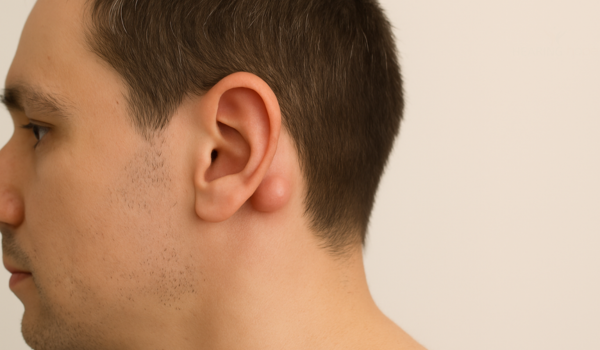
Lump Behind The Ear: Causes, Symptoms, and Treatment
If you’ve noticed a lump behind your ear, you’re not alone—it’s a common concern that can range from harmless to serious. Understanding the cause is the first step to knowing whether it needs medical attention.
A lump behind the ear often shows up as swelling, tenderness, or a bump under the skin. In many cases, it’s caused by infections, swollen lymph nodes, or skin conditions like cysts. These lumps are usually minor and go away on their own. However, some may signal more serious problems, such as mastoiditis or tumours, which require prompt care.
This guide covers the main causes, symptoms, and treatment options for lumps that appear behind the ear. You’ll also learn how to recognise when to see a doctor and what steps you can take at home to ease discomfort. Whether it’s a soft bump from an infection or a firm lump from an injury, knowing what to look out for can help you stay healthy and worry-free.
What Is a Lump Behind The Ear?
A lump behind the ear refers to any abnormal lump, bump, or inflammation located behind the ear. It may be accompanied by redness, pain, or other symptoms, depending on the cause. The swelling can range from mild and temporary to more severe and persistent. Understanding this condition requires identifying its triggers and appropriate management strategies. In many cases, a lump behind the ear on the bone could point to the swelling of a lymph node or the formation of a sebaceous cyst.
Common Causes of Lumps Behind The Ear
Noticing a lump behind your ear can be worrying, but it’s often caused by common conditions. Here are some common causes of swelling or lumps behind the ear:
Infections
Infections are one of the most common causes of swelling behind the ear. These may include:
- Otitis Media: A middle ear infection that can cause pain and swelling behind the ear. In some cases, it may also lead to ear bleeding if the eardrum is affected.
- Mastoiditis: A severe infection affecting the mastoid bone located just behind the ear. It can cause redness, swelling, and sometimes fever.
- Abscess: A buildup of pus resulting from a bacterial infection. It may feel like a soft or painful lump.
Swollen Lymph Nodes
Lymph nodes behind your ears can swell due to:
- Viral or bacterial infections: Common colds, throat infections, or ear infections may cause the lymph nodes to swell.
- Allergic reactions or irritation: Your immune system might respond to allergens or irritants, causing temporary swelling.
A swollen lymph node behind the ear may feel like a small, firm lump under the skin.
Skin Conditions
Some skin issues can also cause lumps or bumps near the ear:
- Sebaceous cysts: Small, harmless lumps filled with fluid that form under the skin.
- Eczema or Dermatitis: Skin inflammation may cause redness, itching, or mild swelling.
Trauma or Injury
An injury near the ear can lead to swelling or a noticeable lump:
- Bruising: A hit or bump can cause the area to swell.
- Hematoma: Blood pooling under the skin may result in a soft or firm lump.
A lump behind the jaw or under the earlobe may appear after an injury.
Tumors
In rare cases, lumps behind the ear can be:
- Benign (non-cancerous) growths: These are usually slow-growing and painless.
- Malignant (cancerous) tumours: These need proper medical attention and diagnosis.
Other Medical Conditions
Other reasons you may feel a lump include:
- Lipomas: These are soft, fatty lumps under the skin that are usually harmless.
- Allergic Reactions: Reactions to certain products or substances can lead to swelling near the ear.
Read the related blog: What causes headaches and earaches at the same time, to understand how these symptoms may be connected and when to seek medical help.
Symptoms of a Lump Behind The Ear
- Redness and Warmth: Often a sign of infection or inflammation.
- Tenderness or Pain: Indicates pressure or irritation in the affected area.
- Lumps or Bumps: Can vary in size and texture, from soft and movable to firm and fixed. A hard lump behind the ear on the skull is often linked to a swollen lymph node beneath the skin.
- Fever or Chills: Suggests an underlying infection that needs prompt attention.
- Fluid Discharge: This may occur with abscesses or severe infections.
- Hearing Issues: Swelling can press against the ear canal, leading to temporary hearing difficulties.
- Hearing Issues: Swelling can press against the ear canal, causing temporary hearing problems. In some cases, if left untreated, it may affect your ability to hear clearly within the human hearing range, which is typically from 20 Hz to 20,000 Hz.
Diagnosis of Lump Behind The Ear
To identify the root cause of ear swelling, healthcare providers may use a variety of diagnostic tools:
- Medical History: Understanding symptoms, past illnesses, and lifestyle factors.
- Physical Examination: Checking the swelling’s size, texture, and associated symptoms, including whether it is a painful lump behind the ear.
- Imaging Tests: CT scans, MRIS, or X-rays for deeper insight into structural issues.
- Lab Tests: Bloodwork or biopsies to detect infections or malignancies.
By assessing these factors, healthcare professionals can determine the underlying cause of the lump and recommend the most appropriate treatment.
When to Seek Medical Attention?
While many cases of lumps behind the ear resolve on their own, certain symptoms require professional intervention:
- Persistent swelling lasting over a week.
- Accompanied by fever, pain, or fluid discharge.
- Hearing difficulties or other unusual symptoms.
Ignoring these signs could lead to complications like chronic infections or permanent hearing loss. Early diagnosis and treatment from hearing care solutions in Delhi can prevent these outcomes.
Conclusion
Lumps behind the ear can arise from a variety of causes, ranging from minor skin conditions to serious infections or growths. While many cases are harmless and resolve quickly, understanding the symptoms and seeking timely care is crucial. By following preventive measures, opting for regular checkups, and consulting experts for a hearing test, you can maintain excellent ear health. Don’t ignore persistent swelling, as early intervention can prevent complications and ensure your auditory well-being.
Frequently Asked Questions
A lump can appear behind the ear due to reasons like infections (such as a cold or ear infection), swollen lymph nodes, cysts, or minor injuries. Sudden swelling is often linked to inflammation or immune response. In most cases, it’s not serious but should be checked if it doesn’t improve.
Most lumps behind the ear are not serious and tend to disappear on their own. Common causes include cysts, infections, and swollen lymph nodes. However, if the lump is painful, keeps growing, or is accompanied by other symptoms like fever or fluid discharge, it’s best to see a doctor.
A swollen lymph node often feels like a small, firm bump under the skin. It may be tender or sore, especially if caused by an infection. These lumps are usually movable and appear during or after illnesses like colds, throat infections, or allergies.
You should consult a doctor if:
- The swelling persists for more than a week.
- You experience symptoms like fever, fluid discharge, or severe pain.
- Hearing difficulties or other unusual symptoms accompany the swelling.
For expert diagnosis and treatment, visit trusted healthcare providers offering hearing care solutions in Delhi and schedule a comprehensive hearing test in Delhi for accurate evaluation.
Dr. Harshi, is an accomplished Audiologist with extensive expertise in treating individuals with hearing impairments.

